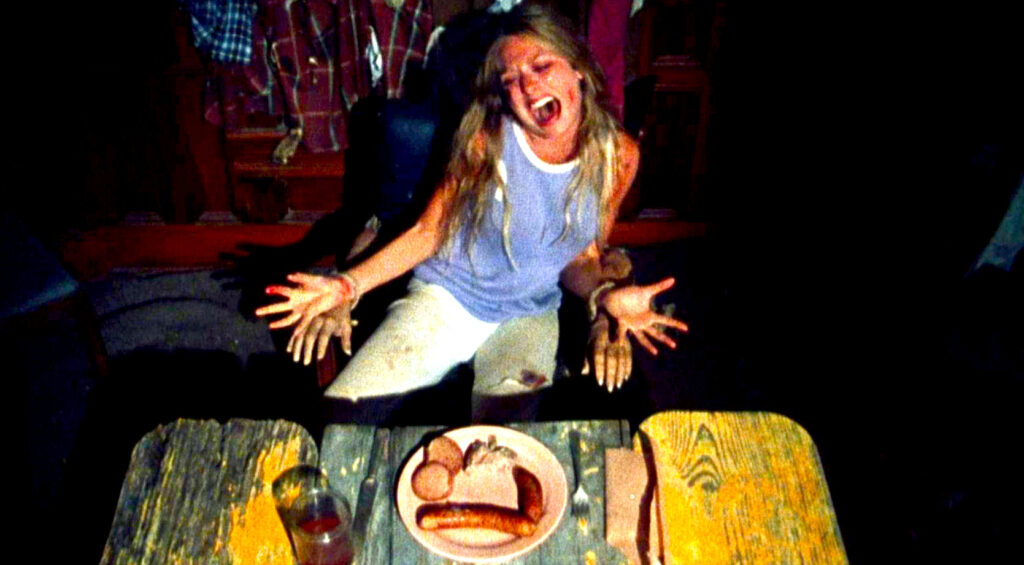American Thanksgiving is right around the corner. When thinking about the holiday in relation to the horror genre, exactly two ideas came to me. The first was an intrusive thought about ThanksKilling that I quickly discarded. The second was the under-appreciated potency of the dinner table. Dinner scenes in horror are some of the most effective and disturbing moments in the genre, and they loom large in my mind. Or maybe I was just hungry.
Either way, I’d like to look at a few iconic horror movie dinner table scenes and explain why they work so well.
What the Dinner Table Means (To Normal People)
The dinner table is an important metaphor in fiction, be it on the page, the stage, or the screen. In his excellent book How to Read Literature Like a Professor, author Thomas C. Foster introduces the idea of dinner scenes being a metaphor for communion, in a secular sense. In short, he says that “breaking bread together is an act of sharing and peace, since if you’re breaking bread you’re not breaking heads.”
This idea is centered around the dinner table forming an instant mini-community, bonding the people sharing a meal. This is why your fantasy dinner party lineup is so important! From The Grinch joining the Whos to carve the roast beast in How the Grinch Stole Christmas to Seema getting over her hangups about Aidan and showing up to dinner with him and Carrie in And Just Like That, sharing food has long been a way for characters to broker peace and foster connections.
The Subversion of the Dinner Table In Horror
The horror genre, as it tends to do, twists that trope and subverts it into something dark and sinister. Breaking heads is definitely on the menu here.
Using such a familiar and comforting setting to either torment the viewer or lay the groundwork for torment to come, the horror genre can propel its metaphors to the forefront. Typically, the dinner table is used in horror to exaggerate the dynamics of a family to the point that they become grotesque parodies of themselves.
Family Tensions in You’re Next Dinner Scene
Look at the tour de force family dinner table sequence in 2011’s You’re Next. While nothing outright horrifying happens for many minutes at the Davison family’s anniversary dinner party, tensions around the table increase as the siblings keep sniping at each other and their partners, building to a bloody crescendo when one of those partners becomes the first victim of a group of home invaders. While that is the only bloody moment in this scene, their dinner table conversation lays the groundwork for how these people will continue to treat each other throughout their ordeal, and perhaps even hints at why said ordeal is happening in the first place.
Emotional Explosions in Hereditary’s Dinner Scene
Another terrific dinner table sequence comes in Hereditary when Annie finally snaps and delivers the iconic “I am your mother” speech, cementing in the character’s growing grief, paranoia, and resentment of her son in an explosion of white-hot rage that she can’t take back, kicking the movie’s series of unfortunate events into high gear.
Class Dynamics in The Menu’s Horror Dinner
Family dynamics are typically at the center of these moments, but class dynamics take a similar beating in The Menu, when Chef Slowik weaponizes the rich’s obsession with exclusivity and experiential cuisine to prevent them from realizing that they are in danger until it is much too late.
When Food Becomes the Horror
Another way for horror to subvert the dinner table trope is by turning the food itself into a source of discomfort and horror. This manifests in many ways, including sequences like the dinner party where Dr. Alan hallucinates a rotting hand emerging from his soup in The Serpent and the Rainbow, Michael eating maggots in The Lost Boys, or Vera’s wound squirting colorful pus into the custard in Braindead/Dead Alive.
Cannibalistic Horror in The Rocky Horror Picture Show
However, some of the best dinner table sequences combine the subversion of both tropes. For instance, The Rocky Horror Picture Show’s birthday party dinner sequence starts one way, in which people are awkwardly gathered around the table largely as a punishment for Janet sleeping with Rocky, but sees its tense disquietude ruptured when it is revealed that they have been eating the corpse of Eddie, who was killed earlier in the movie.
One of the most effective combinations of these two tropes comes in The Texas Chain Saw Massacre, when final girl Sally is forced to watch the twisted and unknowable dynamics play out between Leatherface and his family as they prepare to make her into their meal. The combination of food subversion (cannibalism) and family subversion (everything else) makes the scene so iconic and horrifying that it has been replicated in nearly every Texas Chainsaw movie since then.
Why Horror Dinner Scenes Are the Genre’s Battleground
What all this comes down to is that, while people don’t necessarily die there, the dinner table is nevertheless horror’s most important battleground. It highlights and reinforces the characters and dynamics at play in the center of its stories, setting the stage for whatever grisly events are about to unfold. While saying the right thing at a dinner party can feel like a life-or-death situation in real life, in the horror genre, it quite literally can mean the difference between dying horribly and surviving to see the end credits.
